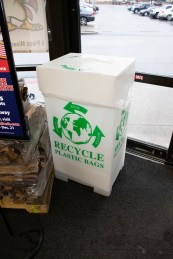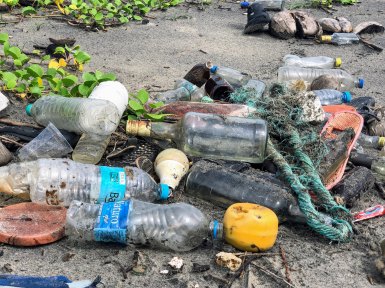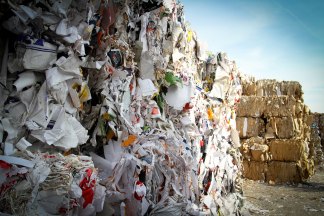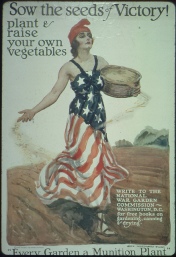I think it was garlic that brought us to the grocery store most recently. That one ingredient for dinner we didn’t have. As the day’s pre-Christmas errands were accomplished in a well planned round trip, the grocery store of choice for that make or break dinner ingredient was the one on the way home. The large automatic glass doors welcomed us into the large pre-entrance lobby, however there was a back-up formed by the one item for sale in the broad expanse of nothing but carts, a pop machine, and a rack of free real estate publications. Four layers high and five layers deep of plastic wrapped 24 pack water bottles on sale for $1.99. We had to wait for the giddy water bottle buyers to finish loading their carts with the limit two apparent sale of the day. I meant to whisper to my husband, maybe I subconsciously I didn’t, “Why don’t they just buy a cup?”

Within ten minutes we had the conveyor belt covered with garlic, potatoes, bread, and several other of the typical items you toss into the cart during a one item purchase intention. I quickly grabbed the reusable bags and tossed them up toward the first of our items hoping to avoid that awkward moment where I barely catch the bagger putting my items in a plastic bag and I have to say, “Oh, sorry, I have my own bags.” Which is typically followed with the frustrated bagger pulling the items back out of the plastic bag, sometimes followed by the bagger attempting to throw the plastic bag in the garbage which forces me into the next awkward moment where I say, “Oh you can use that for the next person.”, then if that is ignored I have to reach for it and say “Here, let me recycle that for you.” Which is followed by me walking ten feet to the grocery bag recycle bin just outside those big glass doors that take you back into the cart lobby.
This time though, I am spared. This time my bags are immediately recognized by the checkout lady. She starts putting the groceries inside them until she changes her mind on the order of things. “I should have put the heavy items in first.” So she takes everything out and creates a pile of all my items slightly sorted next to my two fabric bags. This is when the bagger arrives. The checkout lady puts a few cans in the bag she previously emptied, pushes the bag towards the bagger to finish and tallies up my total. $45.37. And then, that unfortunate reminder that a large majority of people think people like me bring my own grocery bags to the store to get that whopping 5 cents per bag off my grocery bill. The bagger grabs a hand full of small items and puts them in a plastic bag that is about to be put into my big white canvas bag with the little picture of clouds with the happy words “Meaningful Living” written across the now faded blue sky. I hardly catch this happening as I’m trying to manage the chip reader that doesn’t like the way I inserted my card. “Oh, no thank you. Those can go in my bag with everything else.” She looks shocked. They always do. You can hear their thoughts, but plastic bags are free. I smile as she pulls them out of the plastic bag and places them back in my bag as if I was asking her to put the loaf of bread on the bottom then pile the cans on top.

I finally get the machine to recognize my card. Now for watching for the prompts. The one that tells you it’s waiting on the cashier, which it obviously isn’t because the cashier is staring at her screen waiting on me. Then the one that lets me decide credit or debit, followed by the one that wants me to decide if I want cash back. I push NO. I’m almost done, the prompt to put in my pin number appears and out of the corner of my eye so I see the bagger grab the turkey breast slated for Christmas dinner and reach for, yep, a plastic bag. I grab the second fabric bag, it’s green with the National Parks Service logo. I don’t remember when I got it, but it is empty which makes it perfect for meat. I hand it to her, “Meat can go in this bag, I wash it in hot water when I get home.” Stunned again, she slowly retreats from the plastic. “Are you sure, I can wrap the meat in plastic bags then put them in your bag.” It’s not her fault. Why people use “green” bags is not taught in bagger training. It is at this point that my anti-plastic one liner of all anti-plastic one liners pours from my lips; “You know, it’ll end up in the ocean.”
She puts the turkey in the green National Park Service bag, she stares at the bag for a second. Then she responds, in the exact same way everyone responds when I am forced to toss out the plastic ocean statement – “That’s true. I never think of that.”
The plastic bags. The water bottles. The tin and aluminum cans. The milk jugs. The cracker boxes. The toilet paper tubes. The shampoo bottle. All destined to a landfill. Few will be sent to be recycled, and of those maybe only half actually will be.
My husband and I do our best to avoid disposables. Could we do better? Probably, but with each new better habit we make there’s another we realize we need to work on. In the meantime, what disposables do end up in our cars and home go into giant recycling bins in our garage. Once a week my husband loads them up in his truck and drives them a few miles away to the closest recycling drop off- a local trash company. We don’t live in any city limits, so we’ve never had a city provided recycling center. Even if we did it would do us no good as of about a year ago when most the cities around our area closed their recycling centers. The only options left for everyone are taking recycling into the recycling bins at trash centers or paying a little extra to add curbside recycling from your trash service company. Curbside isn’t an option for us. Our almost two car wide curvy country road was determined to terrible and remote for us to have the curbside option. I even offered to take one of the recycle cans home then bring it back when it was full. They said no. Hey, at least we have those drop off bins right?
Not anymore.
While I was putting the groceries away my husband loaded the truck with our recycling.

He wasn’t gone for more than fifteen minutes when he called to tell me we had a problem. The owner came over to him while he was pouring the contents of our cans into the drop off bins to inform him they would be gone by the end of the week. They were losing money on recycling. The owner explained the last time they took the bins to the sorting center they returned with several pallets of compressed film plastic from the recycling center (grocery bags, product wrappers, etc) that had nowhere to go but the landfill.
The argument that the environmental impact of making a green bag will never get used enough to be negated doesn’t account for the following:
Plastic bags are a petroleum product, aka made of oil.
Plastic bags take around 1,000 years to decompose.
By 2050 it is expected that there will be more plastic in the ocean than fish.
Nature’s living creatures don’t know plastic isn’t food or building material.
The average American woman owns 30 outfits, in 1930 she owned nine. Americans also throw away over 68 pounds of clothing per person each year, nearly all of which when made created as much or more of a negative environmental impact as making a reusable bag.
Now what?
Complacency Is Not An Option.
When I was born there were four billion people on the planet and about 50 million metric tons of plastic produced that year. Today there are 7.7 billion people and in the year of 2016, 335 million metric tons of plastic produced. 3.7 billion more people and a yearly increase of 285 million metric tons of plastic produced in just 44 years, with no sign of either slowing down.
Breaking it down-
Why are recycling centers closing?
-Two reasons, the first caused by people refusing to follow rules. Trash goes in trash cans. Trash never goes in recycling containers at schools, or in city/trash service drop-off locations. And yet, that’s what people continued to put in large bins clearly designated for RECYCLING. Furniture, clothing, plastic bags, none of these items can be recycled through the aforementioned drop-off bins.
The second reason these centers are closing is because it has become unprofitable to recycle this way. The value portion of recycling metals is down, plastics have almost no value at best, most cost to recycle and more and more, many types of plastic have nowhere to go but a landfill. Plastics 3-7 and film plastic are especially difficult to get recycled because most of those facilities are in Asia and began closing a few years back as the people of those regions began to realize the recycling process was making their environment unhealthy.
What can we do?
Refuse. Seriously, can you image what kind of planet we are leaving to our future generations? It isn’t just the growing mountains of trash or the growing islands of plastic in the ocean, it is also the chemicals in our trash that will continue to slowly break down over the next several thousands of years, slowly entering the water table, our streams and rivers. We have just begun to understand the effects of long term exposure to microscopic amounts of man made toxins which are already present in the blood of newborn babies as well as every other living creature on earth; including wildlife in the arctic.
Refuse by replacing. Fabric bags instead of plastic bags, travel mugs instead of plastic bottles, cups or foam (which in our are cannot be recycled anywhere). Bamboo or stainless steel straws instead of plastic. Take your leftover containers (glass is the healthiest option) with you to the restaurant, don’t take the foam box.

Recycle glass, aluminum, paper and cardboard. This requires a little extra effort and unfortunately we have become a society addicted to least effort which is exactly what has got us into this mess in the first place. I often think of my grandparents generation during the Great Depression and World War II, saving everything, growing Victory Gardens, running scraps drives- all in the name of patriotic sacrifice to help win a war that threatened not just their lives, but the lives of future Americans, like everyone of you reading this.
Here in the Kansas City metro glass can be easily recycled at Ripple Glass bins which are those big purple bins in Price Chopper parking lots as well as other locations. If you own a restaurant or bar, you need to get glass recycling pickup through Ripple Glass.
Aluminum can be taken to the recycling centers that will actually pay for your cans and foil. Just make sure that foil is clean or it cannot be recycled.
Paper and cardboard might require the most effort, again though, it’s worth it.
Not sure where to take specific items? Ever wonder about electronics, batteries, light bulbs, clothing and all those other things that dwell within our homes and garages? Earth911.com allows you to plug in your zip code, the item you want to recycle and shows you where to take it.
Last but not least, get involved. Get creative, get on the phone, send an email. Talk to your parents, your kids and your friends. Find out if your school district has an education program to teach our upcoming generation how important this is and find out if it is working if they do. I repeat myself,
Complacency Is Not An Option.
Meaningful Living
Audrey Lynn Elder


Right on, Audrey.
Save-a-Lot and Aldi charge customers for bags. Maybe all stores should do this to encourage the use of re-usable bags.
LikeLike
I agree. Sadly, Missouri made a law not allowing any city or municipality to ban plastic bags. In the rare case someone forgets their reusable bag(s) they can also ask for paper at most grocery stores which is at least biodegradable and comes from a renewable resource.
LikeLike
At my work place we do our best to separate the plastic bottles, the glass the tin cans…. all in a separate can labeled recyclable. Our garbage service has a recycling center so it is easy to put all this for one pickup. One day I saw the driver empty the recyclables into the back of his truck with the rest of the garbage. I went out and asked why he wasn’t putting it in the recycling section. I thought, we are doing our best to do our part now why is it all getting mixed together? He was basically too lazy and gave me some excuse that he didn’t have the right kind of truck to pick it up but said he would talk to someone. The next day we had a very large recycling bin outside the work place. I didn’t know they were mixing it all in until I happened to see it. Sometimes we need to be alert and ask questions and not ignore what others do thinking well….. I did my part, not my fault they aren’t doing their.
LikeLike
We written post Audrey we all have to make an effort to resolve the waste problems in our world.
LikeLike